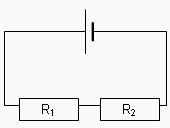PDF chapter test TRY NOW
1. Nature of a conductor:
The resistance of a conductor varies for different types of materials, depending on their nature.
In electrical experiment, it can be easily proved that the conductor's resistance (R) is directly proportional to its length (L) and inversely proportional to its area of cross-section (A).
2. Length of a conductor:
The conductor's resistance (R) is directly proportional to its length (L).

Circuit with resistors
Consider the length of two conductors to be L_{1} and L_{2}, having a resistance of R_{1} and R_{2}, respectively. Assume that the conductors are made of the same material. Then,
3. Area of cross-section of the conductor:
The conductor's resistance (R) is inversely proportional to its area of cross-section (A).
Let the cross-sectional area of two conductors to be A_{1} and A_{2}, having a resistance of R_{1} and R_{2}, respectively.
Since the area of cross-section of a conductor is , where r is the radius of the conductor.
Here, r_{1} and r_{2} be the radii of two conductors. On substituting this value in the above equation, we get
On combining both the equations of the second and third factors, we get
---- (eq. 1)
The constant of proportionality is given as \rho in the above equation. It is known as an electrical resistivity or specific resistance of the material of the conductor.
The (eq. 1) can be written as,
If L = 1\ m, A = 1\ m^2 then, the above equation becomes \rho = R.
The electrical resistivity of a material is defined as the resistance of a conductor of unit length and unit area of cross-section.
Unit:
The SI unit of resistivity is ohm metre or .
A conductor's electrical resistivity is a measurement of its resistance to the passage of an electric current. The electrical resistivity of a material is always constant and independent of its size and shape.
Important!
Nichrome has the highest electrical resistivity, equal to . Hence, this conducting material is used in making heating elements.

Nichrome coil
Reference:
https://upload.wikimedia.org/wikipedia/commons/5/5a/2_resistors_in_series.png
